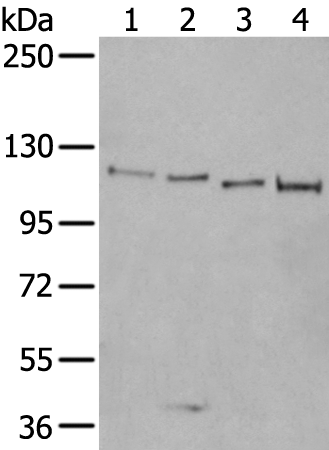
| WB | 咨询技术 | Human,Mouse,Rat |
| IF | 咨询技术 | Human,Mouse,Rat |
| IHC | 咨询技术 | Human,Mouse,Rat |
| ICC | 技术咨询 | Human,Mouse,Rat |
| FCM | 咨询技术 | Human,Mouse,Rat |
| Elisa | 1/5000-1/10000 | Human,Mouse,Rat |
| WB Predicted band size | 109 kDa |
| Host/Isotype | Rabbit IgG |
| Antibody Type | Primary antibody |
| Storage | Store at 4°C short term. Aliquot and store at -20°C long term. Avoid freeze/thaw cycles. |
| Species Reactivity | Human, Mouse |
| Immunogen | Fusion protein of human XRN2 |
| Formulation | Purified antibody in PBS with 0.05% sodium azide and 50% glycerol. |
+ +
以下是关于XRN2抗体的3篇参考文献的简要整理,包含文献名称、作者及摘要内容概括:
1. **"XRN2 links transcription termination to DNA damage and replication stress"**
**作者**:Hatchi E. et al.
**摘要**:该研究利用XRN2抗体进行免疫沉淀和染色质结合实验,发现XRN2在RNAPII转录终止中起关键作用,并揭示其缺失导致R-loop积累,从而引发DNA损伤和复制压力,影响基因组稳定性。
2. **"Human 5'→3' exoribonuclease XRN2 regulates transcription termination by limiting the elongation of RNA polymerase II"**
**作者**:West S. et al.
**摘要**:通过XRN2抗体的ChIP-seq分析,证实XRN2通过降解下游新生RNA促进转录终止,并证明其活性与RNAPII的CTD磷酸化状态相关,为转录-降解偶联机制提供了证据。
3. **"XRN2 is required for the degradation of targeted RNA by the acquired immune response in Arabidopsis"**
**作者**:Gazzani S. et al.
**摘要**:研究利用XRN2抗体进行蛋白质定位和功能缺失实验,发现植物中XRN2通过外切酶活性降解病毒RNA,参与抗病毒免疫反应,揭示其在RNA沉默通路中的新角色。
*注:以上文献均为领域内经典或近年研究,涉及XRN2在转录、基因组稳定性和免疫中的功能,实验方法均依赖XRN2抗体的应用。如需具体期刊信息或DOI,可进一步补充。*
The XRN2 antibody is a crucial tool in molecular biology research, specifically targeting the Xenopus laevis ribonuclease 2 (XRN2) protein, a 3'→5' exoribonuclease involved in RNA metabolism. XRN2 plays a vital role in processing and degrading various RNA substrates, including mRNA, rRNA, and non-coding RNAs. It is essential for transcription termination by degrading nascent transcripts associated with RNA polymerase II, ensuring proper gene expression. In the cytoplasm, XRN2 (also called Dhm1 in flies or Rat1 in yeast) mediates mRNA turnover, while its nuclear isoform contributes to rRNA maturation and surveillance of small nuclear RNAs (snRNAs).
The antibody is widely used in techniques like Western blotting, immunoprecipitation, and immunofluorescence to study XRN2's localization, expression levels, and interactions. Research utilizing XRN2 antibodies has advanced understanding of RNA quality control mechanisms, transcription-coupled decay, and genome stability. Dysregulation of XRN2 is linked to neurological disorders, cancer, and viral infection responses, highlighting its biological significance. Most XRN2 antibodies are raised in rabbits or mice against conserved epitopes, ensuring cross-reactivity with homologs in humans (hXRN2) and model organisms. Their application continues to drive discoveries in RNA biology and disease pathogenesis.
×